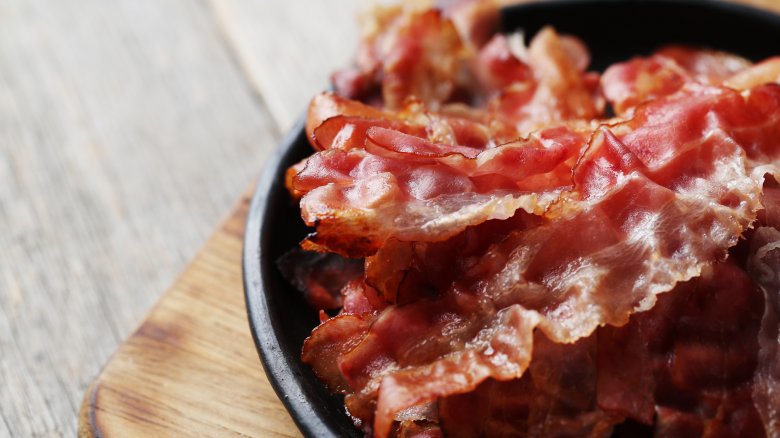The Real Reason You Should Start Cooking Bacon In Water
Bacon really is the best, right? It's versatile and can be enjoyed as part of another recipe, slapped on a cheeseburger, or eaten by itself in all its glory. But if you've ever eaten bacon that wasn't cooked well (or perhaps it was cooked a little too well), then it's basically the worst thing ever — it's kind of like opening a present on Christmas, but the box is empty once you get it unwrapped. Some people prefer crispy bacon, while others prefer chewy, and still others prefer bacon that manages to be both crispy and chewy at the same time. So how do you cook bacon that is crispy without being too crisp, and chewy without being too rubbery?
There are a ton of different ways to cook bacon, from traditionally frying it in a skillet to slow cooking it in your oven at low temps — and everything in between. Each of these methods do have their drawbacks, though, and can leave you with unappetizing breakfast meat that you don't really enjoy eating. Frying in a skillet can go wrong in a hurry, as your bacon can go from "just perfect" to "fried charred strip of pork" in an instant. Cooking in the oven on a baking sheet at low temps will give you perfectly delightful bacon, but it can take so long, and if you pull it out too soon due to impatience or lack of time, then you just have gross, undercooked bacon.
Thankfully, there is a solution for all of these problems, and it doesn't take a ton of time or leave you with bacon you'll want to throw in the trash. You've probably never considered this method (or even thought of it), though. It involves placing the bacon in a skillet, on the stovetop, and covering it with water. Yes, really. While this may sound completely disgusting — after all, wouldn't this leave you with a greasy mess of limp bacon?! — it's actually the best method for bacon that hits that sweet spot of chewy and crispy.
What makes this method even more appealing is that the bacon cooks up plump and juicy without all the grease splattering your stove, your clothes, and the floor. Perfectly cooked bacon without all the mess? Where do we sign up?
Cook's Illustrated outlines this water-cooking method, and though it's definitely a departure from the usual methods, it's actually really simple. While it's not quite the same as tossing your bacon strips into a large pot full of water and boiling for a set amount of time, as you would with dry pasta, you are still technically boiling your bacon. That's where the resemblance ends, though, because it's more of a quick boil paired with traditional frying. You definitely don't want to skip the frying step.
To make your perfectly cooked bacon, lay the strips in a skillet (or you can cut them into pieces instead of leaving the strips whole, if you'd like). Add just enough water to cover all of the strips, and turn the burner on high heat. Wait for the water to boil, then lower the heat to medium. As the bacon cooks and plumps, the water will eventually simmer away.
Once the water has evaporated, turn the heat down to medium-low. By this time the fat (which would have usually launched itself onto your clothes and the kitchen floor) will have been rendered by the cooking process, which means that the chances of the meat burning while you try to cook the fat down is lessened. The reason you'll want to continue to cook your bacon without water is to get that meat crisped up, because most people likely have no desire to chow down on rubbery bacon. This final step will allow you to brown the bacon to your desired doneness.
What you'll be left with is bacon that isn't warped and ribbony, it won't be dry or brittle, and it won't be tough or excessively chewy. Instead, you'll have a plate of gorgeous, plump bacon that melts in your mouth.
It might be hard to let go of your "regular" cooking method, but once you try cooking your bacon in water, you will probably never do it any other way again.
